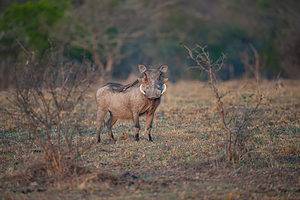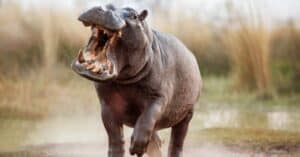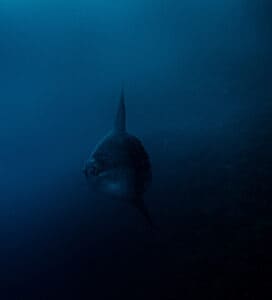Grizzly bears are tough animals despite not hunting for most of their food. They’re large, powerful, and fast. While we have pitted them against many other creatures in our ongoing series of epic battles, they have typically emerged victorious. What happens if we put a grizzly bear vs rhino battle on display, though?
Can the grizzly bear use its strength and viciousness to eke out a victory against a massive animal covered in the biological equivalent of armor?
Let’s break down this fight and see what happens!
Comparing a Grizzly Bear and a Rhino

| Grizzly Bear | Rhino | |
|---|---|---|
| Size | Weight: anywhere between 400 and 700 pounds on average, but over 1,000 pounds in some cases Length: between 7 and 10 feet, though 10 feet is rare Height: 3 to 4.5 feet at the shoulder | Weight: from 1,700 to 7,700 pounds Height: about 4.3 to 6 feet Length: from 11 to 15 feet |
| Speed | – Has a top speed of 35 mph when chasing prey on land | – Top speeds of between 24 and 35 mph |
| Defenses | – Layer of fat that can be several inches thick – Dense fur – Thick skin – Large body frightens off most other animals – Raw power that makes it hard to take down the grizzly | – Has thick armored skin that measures 2 inches thick – Its thick skin is composed of two layers of collagen – Can run away from trouble at a reasonably high speed |
| Offensive Capabilities | – 3-inch-long canine teeth can bite deeply into prey – Has a 975 PSI bite power that they use to break bones or grasp animals and shake them – Has large paws with claws that measure between 3 and 5 inches in length – Can swat or slash prey with incredible power | – Will use their horns to attack predators – Rhino horns measure between 8 and 30 inches or slightly more – May also trample their prey with their large bodies – Powerful enough to roll a car over |
| Predatory Behavior | – More of a scavenger and gatherer than a hunter – Can use ambush and cursorial methods to hunt prey | – No predatory behaviors since they are herbivores – Lack aggression except when they feel threatened |
What Are The Key Differences Between a Grizzly Bear and a Rhino?
The most significant differences between a grizzly bear and a rhino can be found in their size, morphology, and the methods they use to obtain their food. Grizzly bears are quadrupedal mammals with dense fur that usually weigh up to 700 pounds and stand about 3 to 4.5 feet tall at the shoulder. They usually gather or scavenge their food, but they can also be vicious predators.
Meanwhile, rhinos are massive creatures that can weigh up to 7,000 pounds, stand 6 feet tall at the shoulder, and grow upwards of 11 to 15 feet. They are known for their thick skin that is akin to armor and the fact that some of them have large horns that can measure between 8 and 30 inches in length. Each of the five extant species of rhinos is a herbivore.
These differences will have a substantial impact on the fight, but we need more information to determine the winner.
What Are the Key Factors in a Fight Between a Grizzly Bear and a Rhino?
Every fight in the wild comes down to a handful of different factors. This battle is no different. So, we are going to consider elements like offensive powers, size, and speed. Yet, we also want a well-rounded view of this fight, so we’re going to talk about predatory behaviors and defenses as well. By the time we’re done, we’ll have a great idea of how these animals measure up and know who should win.
Grizzly Bear vs. Rhino: Size
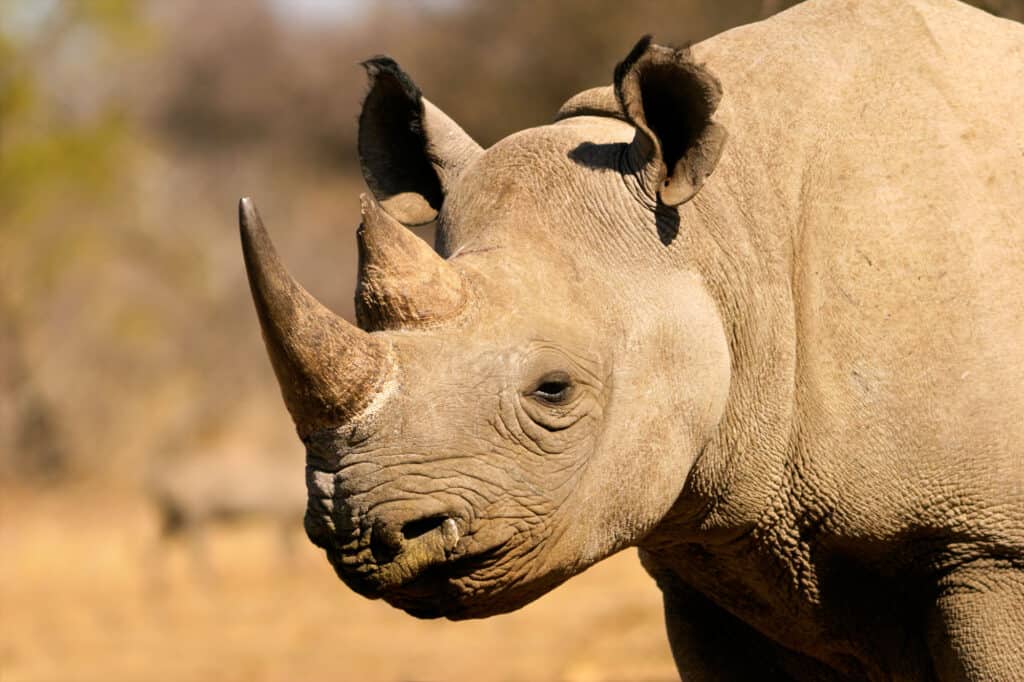
The rhinoceros weighs more than the grizzly bear.
©iStock.com/EcoPic
Rhinos are much larger than grizzly bears, even though the latter are big in their own right. The average rhino weighs between 1,700 and 7,700 pounds, stands 4.3 to 6 feet tall at the shoulder, and grows from 11 to 15 feet in length. This depends greatly on the species, though. The white rhinoceros is usually considered the largest species.
Meanwhile, grizzly bears can weigh between 400 and 700 pounds most of the time, but they can get as heavy as 1,200 pounds. They stand between 3 and 3.5 feet tall at the shoulder, but they can reach heights of over 4 feet sometimes as well. They grow between 7 and 10 feet long.
All in all, rhinos have a significant size advantage.
Grizzly Bear vs. Rhino: Speed
Grizzly bears and rhinos are both large animals that know how to get around in a hurry. On average, grizzly bears can reach a top speed of about 35 mph. However, rhinos can charge at about 34 mph, roughly the same speed as a grizzly despite being many times heavier than them.
The grizzly bear may have a very small advantage in speed.
Grizzly Bear vs. Rhino: Defenses
The rhino is known for having very stout defenses. The animal has thick layers of skin that are two inches thick and composed of two layers of collagen. This protective hide can turn the bites of predators into a nuisance, not allowing them to penetrate deeply enough to do serious harm. Moreover, the rhino is fast and powerful, so bringing it down is tough.
Grizzly bears also have a lot of raw power that makes them difficult to prey upon. Furthermore, they’re known for their thick fur, skin, and layers of fat that offer them protection against bites and other attacks. However, their flesh isn’t as protective as a rhino’s.
Rhinos have a defensive advantage in this battle.
Grizzly Bear vs. Rhino: Offensive Capabilities
Rhinos have a fair amount of offensive power despite being herbivores. The rhinos that have horns can put them to use at the end of a charge to impale enemies. These horns can measure between 8 and 30 inches most of the time, but they can get even longer. All rhinos can use their immense body weight and power to knock enemies over and trample them to death.
Grizzly bears have a multi-faceted attack pattern. They maul their prey. That usually includes biting with 975 PSI of power, driving 3-inch canines and 1-inch teeth into their prey over and over again while swatting them with their paws and slashing them with claws. Grizzlies are known for biting prey on the back and neck, bringing it to the ground before finishing it off.
Although their attack methods are unique, both animals have highly effective offensive powers.
Grizzly Bear vs. Rhino: Predatory Behavior
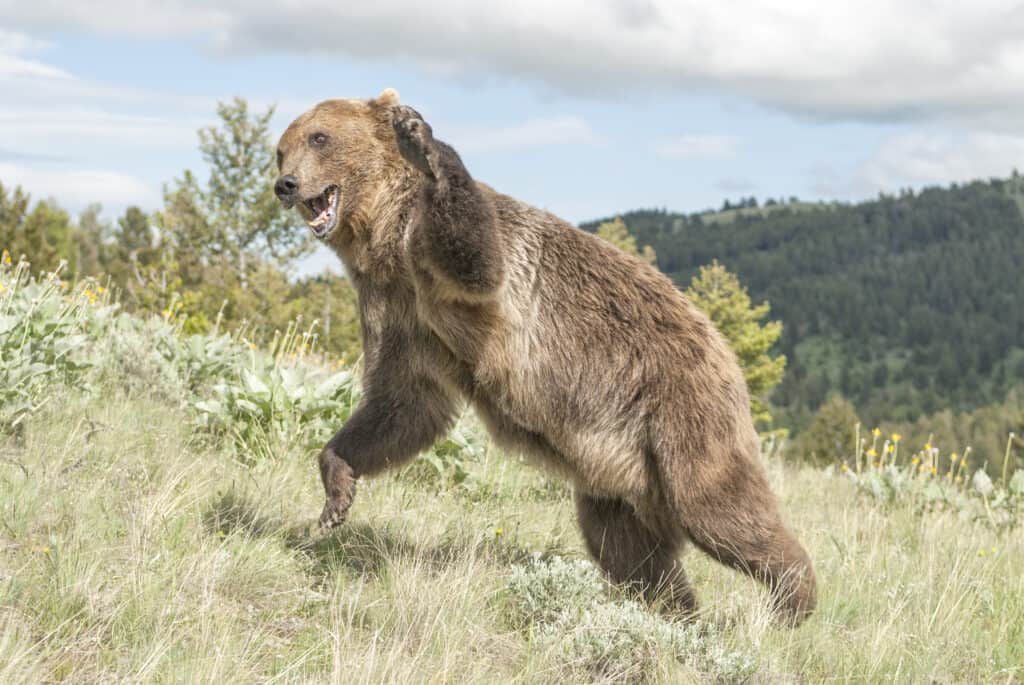
Although the grizzly bear is not highly predatory, it still has the advantage over a rhino.
©outdoorsman/Shutterstock.com
The average grizzly bear is not a highly predatory creature. They usually seek their food through scavenging efforts or by gathering. However, they do have a prey drive. These animals don’t ambush prey in the same way that a stalking tiger does. Grizzly bears try to use the element of surprise to start the hunt, and they ultimately chase their prey and wear it down with brutal attacks.
Meanwhile, rhinos do not have any predatory behaviors. They are merely herbivores.
Grizzly bears have the advantage in terms of predatory behaviors.
What is the Grizzly Bear’s Biggest Enemy?
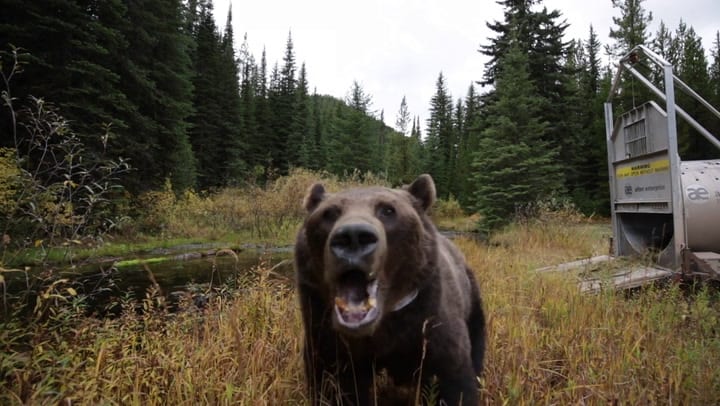
Grizzly bears can turn aggressive and launch attacks swiftly when they or their cubs are threatened by other animals or humans. Approximately half of grizzly cubs don’t survive to adulthood, mainly due to diseases and natural predators such as mountain lions, wolves, and adult male grizzlies.
Additionally, hunters are now the primary factor behind the mortality of grizzly bears. The most significant threat to grizzlies comes from humans.
Furthermore, one of the few animals besides a rhino that may be stronger than a grizzly bear is a Silverback Gorilla. The primary advantage of a Silverback lies in its exceptionally powerful muscles. Despite the immense strength of grizzly bears, gorillas, chimps, and monkeys possess significantly greater muscle strength compared to other animals of similar size.
Who Would Win in a Fight Between a Grizzly Bear and a Rhino?
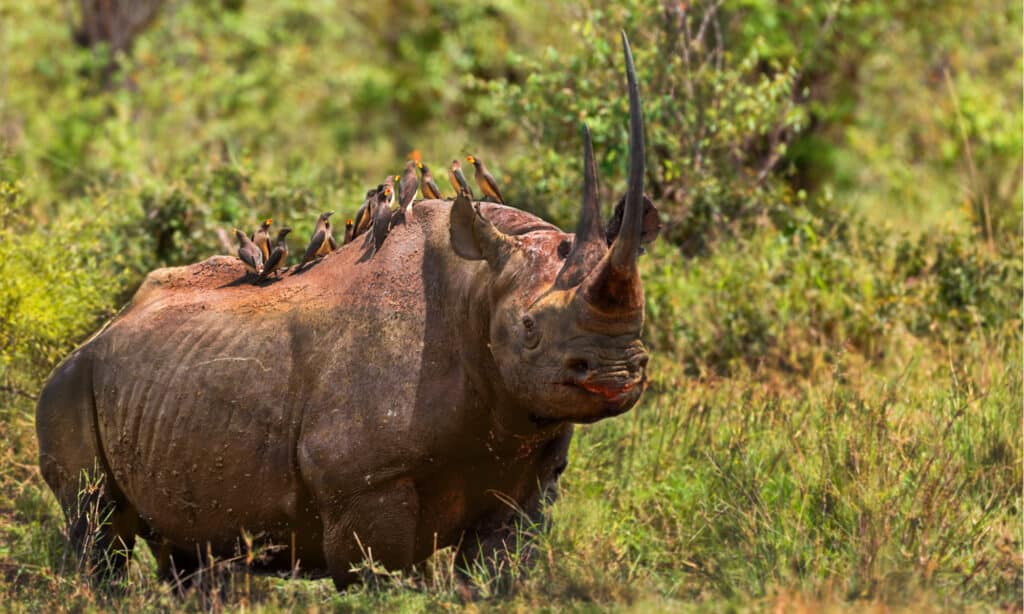
Though it may take time, a rhino will eventually take down a grizzly bear.
©Maggy Meyer/Shutterstock.com
A rhino would win a fight against a grizzly bear. Grizzly bears are tough animals. They’re also far more aggressive than the average solitary rhino. In a fight to the death, though, the rhino would clearly recognize that the grizzly is a threat that needs to be frightened off or eliminated. This animal would fight back with everything it has.
Rhinos don’t have a great sense of sight, so the encroaching grizzly bear may go unnoticed until it is too late for the rhino to get a good charge speed going. In that case, the grizzly will do what it does best. It’ll climb on the rhino and start biting at vital areas. It’ll go for the head, neck, and back. While it can exert a ton of force, the grizzly is not strong enough to break through the skin and crush the bones beneath.
The grizzly bear may strike first, but the rhino will strike last. Either way, the beginning of the end will be the rhino moving around until it can get the grizzly bear off of its back. From then, the rhino will trample, crush, and possibly impale the bear on its horn. The grizzly simply can’t do enough damage to bring down the rhino, but the same can’t be said for the rhino. It may take some time, but the rhino will take down the grizzly or make it flee.
Who Could Beat the Rhino?
When it comes to battles, rhinos are formidable opponents. They have been known to take on predators such as lions and hyenas and come out victorious. After all, they are practically armor-plated dinosaurs. So, what about prehistoric animals? Could they stand a chance in a fight against the mighty rhino? Some experts believe that large dinosaurs like Tyrannosaurus Rex could have posed a threat to even the toughest of rhinoceroses. However, there is no evidence to prove this theory, so we will never know for sure! It’s safe to say that any animal on earth would need something special, like an extra-large dose of courage or luck, if they wanted to beat a rhino in battle!
The photo featured at the top of this post is © Maggy Meyer/Shutterstock.com
Thank you for reading! Have some feedback for us? Contact the AZ Animals editorial team.



